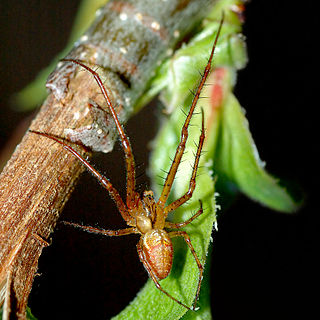
Long-jawed orb weavers or long jawed spiders (Tetragnathidae) is a family of araneomorph spiders first described by Anton Menge in 1866. They have elongated bodies, legs, and chelicerae, and build small orb webs with an open hub with few, wide-set radii and spirals with no signal line or retreat. Some species are often found in long vegetation near water.

The Entelegynae or entelegynes are a subgroup of araneomorph spiders, the largest of the two main groups into which the araneomorphs were traditionally divided. Females have a genital plate (epigynum) and a "flow through" fertilization system; males have complex palpal bulbs. Molecular phylogenetic studies have supported the monophyly of Entelegynae.
Pinkfloydia is a genus of small long-jawed spiders containing a single described species, Pinkfloydia harveii, known from Western Australia. Individuals reach maximum lengths of 4.5 millimetres (0.18 in) and have a unique rounded, cone-shaped head structure with one pair of large eyes and 3 pairs of smaller eyes. The genus is named after British rock band Pink Floyd.
Schenkeliella is a monotypic genus of Long-clawed orb weaver spiders in the Tetragnathidae family. As of 2017, it contains only one species, Schenkeliella spinosa. It is endemic to Sri Lanka.
Antillognatha is a genus of spiders in the Tetragnathidae family. It was first described in 1945 by Bryant. As of 2017, it contains only one species, Antillognatha lucida, found on Hispaniola.
Dianleucauge is a genus of spiders in the Tetragnathidae family. It was first described in 1994 by Song & Zhu. As of 2017, it contains only one species from China, Dianleucauge deelemanae.
Doryonychus is a genus of spiders in the Tetragnathidae family. It was first described in 1900 by Simon. As of 2017, it contains only one species, Doryonychus raptor, known only from the Hawaiian island of Kauai.
Dyschiriognatha is a genus of spiders in the Tetragnathidae family. It was first described in 1893 by Simon. As of 2017, it contains 5 species.
Eryciniolia is a genus of spiders in the Tetragnathidae family. It was first described in 1912 by Strand. As of 2017, it contains only one species, Eryciniolia purpurapunctata, found in New Zealand.
Homalometa is a genus of spiders in the Tetragnathidae family. It was first described in 1898 by Simon. As of 2017, it contains 3 species.
Mecynometa is a genus of spiders in the Tetragnathidae family. It was first described in 1894 by Simon. As of 2017, it contains 3 species.
Mitoscelis is a genus of spiders in the Tetragnathidae family. It was first described in 1890 by Thorell. As of 2017, it contains only one species, Mitoscelis aculeata, found on Java.
Nanningia is a genus of spiders in the Tetragnathidae family. It was first described in 1997 by Zhu, Kim & Song. As of 2017, it contains only one Chinese species, Nanningia zhangi.
Nanometa is a genus of spiders in the Tetragnathidae family. It was first described in 1908 by Simon. As of 2017, it contains only one species, Nanometa gentilis, found in western Australia.
Neoprolochus is a genus of spiders in the Tetragnathidae family. It was first described in 1927 by Reimoser. As of 2017, it contains only one species, Neoprolochus jacobsoni, found on Sumatra.
Opadometa is a genus of spiders in the Tetragnathidae family. It was first described in 1951 by Archer. As of 2017, it contains 4 Asian species.
Parazilia is a genus of spiders in the Tetragnathidae family. It was first described in 1938 by Lessert. As of 2017, it contains only one species, Parazilia strandi, found in Congo.
Timonoe is a genus of spiders in the Tetragnathidae family. It was first described in 1898 by Thorell. As of 2017, it contains only one species, Timonoe argenteozonata, found in Myanmar.
Zygiometella is a genus of spiders in the Tetragnathidae family. It was first described in 1995 by Wunderlich. As of 2017, it contains only one species, Zygiometella perlongipes, found in Israel.


